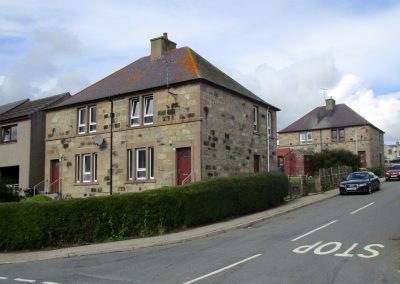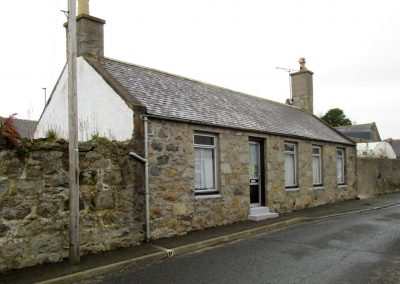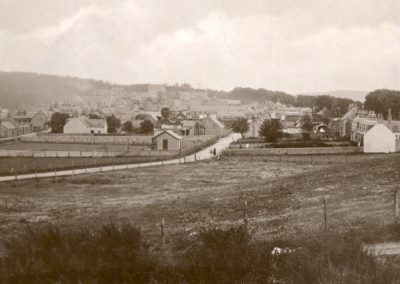The Interwar Period
Note: House numbers were altered on two occasions during this period. Subheadings use 2018 numbering, but previous numbers may appear in the text.
Homes For Heroes – 167-177 North Street (1922):
The Town Council agreed in 1919 to build six houses – three double cottages – on a site at North Street between the tennis court and Causewayend Quarry. The newly appointed Burgh Architect visited Macduff to see its plans for a housing scheme. In 1920 local builders C & J Grant beat George Youngson, mason, to the contract.
The Council was given permission by the Department of Health to borrow money for the project and in 1921 a housing account was opened at North of Scotland Town & County Bank, Aberchirder. There was a prolonged debate between Council and Department about the level at which rents should be set, the latter believing £16 a year was too low. In 1922 the houses, 167-177 North Street, were completed and the first tenants – all comfortably off people like schoolteacher Jessie Smith – moved in.
Slum clearance – 5-11 Main Street (1935):
In 1923 and 1924 two further Housing Acts offered subsidies to local authorities to build council houses but Aberchirder decided not to become involved. This despite the fact that at this time the Town Council had discussed concerns about the state of several properties in Long Lane and of a row of six little houses on the last feu at the top of Main Street, next to the Aul’ Jail. The latter were owned by Peter Anderson, a builder, one of a family of ten children of James Anderson of Drakemyre Farm near Glendronach.
At a meeting of the Town Council in February 1923 a report was presented by the Medical Officer of Health who, along with the Sanitary Inspector, had visited three of the houses, occupied by John Whyte, James Whyte and James Burns.: “These houses constitute a single block of dwellings. The walls are of stone and not plumb. The east gable is requiring pointing. The roof is corrugated iron over thatch. There are no rain water rhones. The accommodation consists of a single apartment with closet in each house. On account of the general dilapidated state of these houses the Medical Officer declared that they are unfit for human habitation.”
More council housing – 181-187 North Street (1931):
The 1930 Housing Act offered local authorities a subsidy of £2.10s for every person rehoused.
The Town Council remained reluctant to build any more houses, but a letter from the Department of Health pointed out that there was a need for more houses for the working class in the Burgh, that substandard houses should be repaired and unfit houses closed. This was backed by a report by the Medical Officer of Health, who pointed out that: “Aberchirder has an unduly large proportion of the hawker class, who reside there the winter months and during the remainder of the year lock up their houses and adopt a wandering life. It is a very difficult matter to know how to deal with these people. No proprietor will let them a decent house and if the houses they occupy are closed as unfit for human habitation there is no other accommodation available. The houses I inspected yesterday are as follows:
1. House in Long Lane occupied by Mrs Marshall. This house has patches of dampness due to want of painting of the walls. The proprietor should be called in to remedy this defect.
2. House in Long Lane occupied by Mrs Burns. This house is in the same condition as the above one and the same remedy is required.
3. House 49 South Street occupied by John Whyte and family. This house is in a state of general dilapidation and a closing order should be made.
4. House 50 South Street occupied by David White. This house is approaching a condition of unfitness for human habitation on account of general dilapidation. It is not worth repair but meantime might be allowed to be occupied.
5. The houses at top of Main Street occupied by Mrs Smart and James Cameron. These houses are not worth repair but meantime may be allowed to continue to be occupied…”
The Town Council eventually accepted there was a need for more working class housing and agreed to build a block of four 3-apartment houses. The Council first thought to use land next to the tennis courts in Main Street – which would later become the play park – but then decided to site them on the other side of North Street next to the bungalow (No. 179) built in 1928 for the Misses Cowie. A loan of £1500 was secured to cover the cost of building, and a new sewer had to be laid from “the new houses at Causewayend” to a junction with the burgh sewer at the Bowling Green gate in North Street. The first tenants moved in during 1931.
More slum clearance – 38 & 39 and 45 & 46 South St with 60 & 61 Southview Terrace (1936):
While the 5-11 Main Street flats were still being built, the Town Council made its first move into South Street, where many of the little houses between Southview (No.21 South Street) and School Lane were a century or more old, and had become dilapidated. The feus ran from South Street to Long Lane, and some had houses fronting onto a lane or Long Lane itself, but all had South Street as the address. The Town Council intended to build new houses at both ends of the feus.
The Banffshire Journal reported in 1896 how kindness was shown to the poor at the festive season, as it was each year: “On New Year’s Day eighty poor people in Aberchirder were each presented with ½ lb of excellent tea, generously provided by Provost George, Superior of the Burgh. On the same day the aged and infirm poor who are kept in the Parish Council Lodging House were supplied with a good dinner by Dr Whitton. Others also have been doing many kind acts to the poor.”
Slum clearance gathers pace – 26, 27 & 30-33 South Street (1937):
Slum renovation – 161-165 North St (1938, since demolished):

















